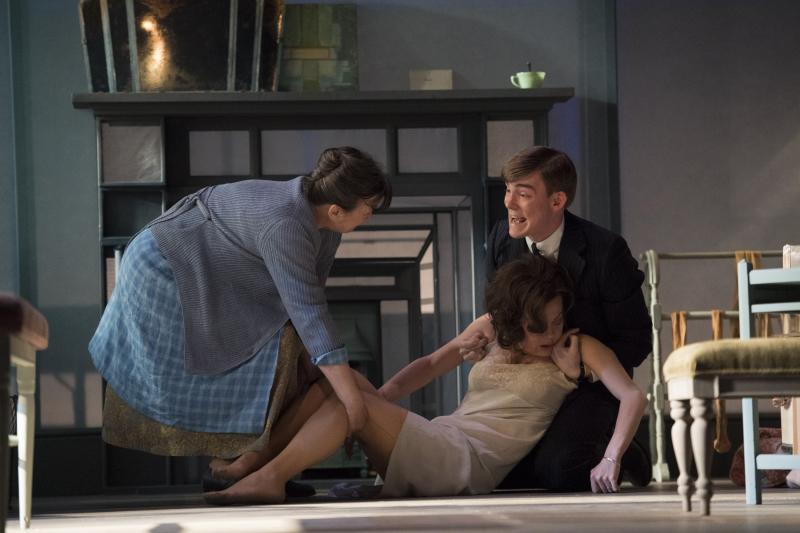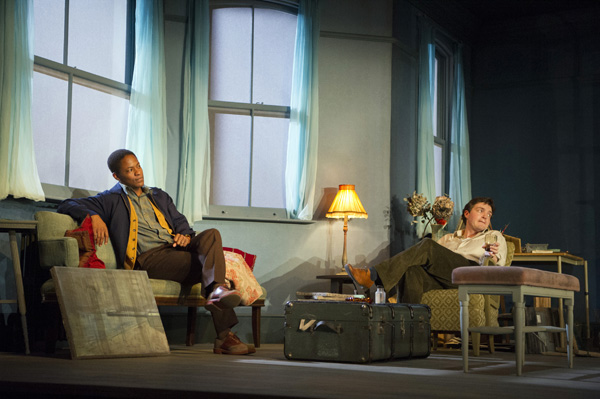The Deep Blue Sea, National Theatre | reviews, news & interviews
The Deep Blue Sea, National Theatre
The Deep Blue Sea, National Theatre
Terence Rattigan’s best play stars Helen McCrory in an uncertain production

From being the Aunt Sally of contemporary British theatre, attacked by the angry young men in the 1950s and the new wave of social and political realists for three decades after that, playwright Terence Rattigan is now well and truly rehabilitated. For the past quarter of a century, both his major and his minor works have been regularly revived.
Originally put on in 1952, The Deep Blue Sea begins with the arresting image of a woman (McCrory) slumped in front of a gas fire in a squalid flat. She is Hester Collier, a posh clergyman’s daughter who has left her upper-class husband, a judge called Sir William Collyer, to live with her lover, Freddie, a veteran of the Battle of Britain and now an unemployed test pilot who drinks too much. In despair because Freddie’s love for her seems lukewarm (he’s forgotten her birthday), while her passion feels overwhelming, Hester has attempted suicide. As she says to her landlady Mrs Elton, “When you’re between any kind of devil and the deep blue sea, the deep blue sea sometimes looks very inviting.”
McCrory’s range is wide, and her performance is compelling
The play explores the various emotions not only of Hester and Freddie, who tells his friend Jackie that he “can’t be a ruddy Romeo all the time”, but also of Sir William, and another couple – Philip and Ann Welch – who react very conventionally to Hester’s plight. Rattigan described the play as “a study of obsession and of the shame that a sensitive, clear-minded and strong-willed woman must feel when she discovers she has inside her a compulsion that seems too strong for her to resist”. In the 1950s, of course, both homosexuality and attempted suicide were illegal, which is perhaps why Hester is drawn to Mr Miller, a mysterious ex-doctor and fellow tenant, who has been struck off the medical register for an offence that is only hinted at, but is probably homosexuality.
McCrory is always watchable, and here she makes a long journey from exhausted fragility, through a deep shame about her sexuality, to desperation about being abandoned, to a kind of grim reconciliation with reality. There are some moments of tenderness as well as despair, but also a fair lashing of anger. When she talks about her suicide attempt her voice cracks – with regret at her failure. Her range is wide, and the effect of her performance is compelling. The same, alas, cannot be said for Carrie Cracknell’s production.
 Although the keynote to Rattigan’s work is emotional reticence, Cracknell has chosen to explore a more contemporary sensibility. The results are mixed, with a lack of coherence more in evidence than cohesion. Designer Tom Scutt has created a shabby flat in a massive house, whose stairs, corridors and other flats are visible, inhabited by ghostly spirits, while cinematic music groans in the background. Against this background the passionate feeling, and overt sexuality, of the main characters is emphasised here, which does make sense.
Although the keynote to Rattigan’s work is emotional reticence, Cracknell has chosen to explore a more contemporary sensibility. The results are mixed, with a lack of coherence more in evidence than cohesion. Designer Tom Scutt has created a shabby flat in a massive house, whose stairs, corridors and other flats are visible, inhabited by ghostly spirits, while cinematic music groans in the background. Against this background the passionate feeling, and overt sexuality, of the main characters is emphasised here, which does make sense.
McCrory is such a star that the actors playing Freddie (Tom Burke) and Collyer (Peter Sullivan) swing around her, while both Mrs Eldon (Marion Bailey) and Mr Miller (Nick Fletcher) seem under-characterised. At his best, Burke (pictured above right with Adetomiwa Edun’s Jackie) is convincingly frustrated. However, the Welches (Hubert Burton and Yolanda Kettle) are more millennial than mid-century, he public school, she visibly pregnant. Too often, on the press night, the cast attracts mocking laughter rather than audience sympathy. And the final visual metaphor of a fried egg as a symbol of emotional survival is both powerful and, frankly, a bit bathetic.
rating
Explore topics
Share this article
Add comment
The future of Arts Journalism
You can stop theartsdesk.com closing!
We urgently need financing to survive. Our fundraising drive has thus far raised £49,000 but we need to reach £100,000 or we will be forced to close. Please contribute here: https://gofund.me/c3f6033d
And if you can forward this information to anyone who might assist, we’d be grateful.

Subscribe to theartsdesk.com
Thank you for continuing to read our work on theartsdesk.com. For unlimited access to every article in its entirety, including our archive of more than 15,000 pieces, we're asking for £5 per month or £40 per year. We feel it's a very good deal, and hope you do too.
To take a subscription now simply click here.
And if you're looking for that extra gift for a friend or family member, why not treat them to a theartsdesk.com gift subscription?
more Theatre
 Ragdoll, Jermyn Street Theatre review - compelling and emotionally truthful
Katherine Moar returns with a Patty Hearst-inspired follow up to her debut hit 'Farm Hall'
Ragdoll, Jermyn Street Theatre review - compelling and emotionally truthful
Katherine Moar returns with a Patty Hearst-inspired follow up to her debut hit 'Farm Hall'
 Troilus and Cressida, Globe Theatre review - a 'problem play' with added problems
Raucous and carnivalesque, but also ugly and incomprehensible
Troilus and Cressida, Globe Theatre review - a 'problem play' with added problems
Raucous and carnivalesque, but also ugly and incomprehensible
 Clarkston, Trafalgar Theatre review - two lads on a road to nowhere
Netflix star, Joe Locke, is the selling point of a production that needs one
Clarkston, Trafalgar Theatre review - two lads on a road to nowhere
Netflix star, Joe Locke, is the selling point of a production that needs one
 Ghost Stories, Peacock Theatre review - spirited staging but short on scares
Impressive spectacle saves an ageing show in an unsuitable venue
Ghost Stories, Peacock Theatre review - spirited staging but short on scares
Impressive spectacle saves an ageing show in an unsuitable venue
 Hamlet, National Theatre review - turning tragedy to comedy is no joke
Hiran Abeyeskera’s childlike prince falls flat in a mixed production
Hamlet, National Theatre review - turning tragedy to comedy is no joke
Hiran Abeyeskera’s childlike prince falls flat in a mixed production
 Rohtko, Barbican review - postmodern meditation on fake and authentic art is less than the sum of its parts
Łukasz Twarkowski's production dazzles without illuminating
Rohtko, Barbican review - postmodern meditation on fake and authentic art is less than the sum of its parts
Łukasz Twarkowski's production dazzles without illuminating
 Lee, Park Theatre review - Lee Krasner looks back on her life as an artist
Informative and interesting, the play's format limits its potential
Lee, Park Theatre review - Lee Krasner looks back on her life as an artist
Informative and interesting, the play's format limits its potential
 Measure for Measure, RSC, Stratford review - 'problem play' has no problem with relevance
Shakespeare, in this adaptation, is at his most perceptive
Measure for Measure, RSC, Stratford review - 'problem play' has no problem with relevance
Shakespeare, in this adaptation, is at his most perceptive
 The Importance of Being Earnest, Noël Coward Theatre review - dazzling and delightful queer fest
West End transfer of National Theatre hit stars Stephen Fry and Olly Alexander
The Importance of Being Earnest, Noël Coward Theatre review - dazzling and delightful queer fest
West End transfer of National Theatre hit stars Stephen Fry and Olly Alexander
 Get Down Tonight, Charing Cross Theatre review - glitz and hits from the 70s
If you love the songs of KC and the Sunshine Band, Please Do Go!
Get Down Tonight, Charing Cross Theatre review - glitz and hits from the 70s
If you love the songs of KC and the Sunshine Band, Please Do Go!
 Punch, Apollo Theatre review - powerful play about the strength of redemption
James Graham's play transfixes the audience at every stage
Punch, Apollo Theatre review - powerful play about the strength of redemption
James Graham's play transfixes the audience at every stage
 The Billionaire Inside Your Head, Hampstead Theatre review - a map of a man with OCD
Will Lord's promising debut burdens a fine cast with too much dialogue
The Billionaire Inside Your Head, Hampstead Theatre review - a map of a man with OCD
Will Lord's promising debut burdens a fine cast with too much dialogue

Comments
I do not recognise that this
I felt the audience was being
I felt the audience was being asked to laugh at lines which might have been taken more seriously in 1952. We weren't laughing at but with. That pleased me because it shows that the play is a classic, open to some reiterpretation from one generation to another.
I thought the production was